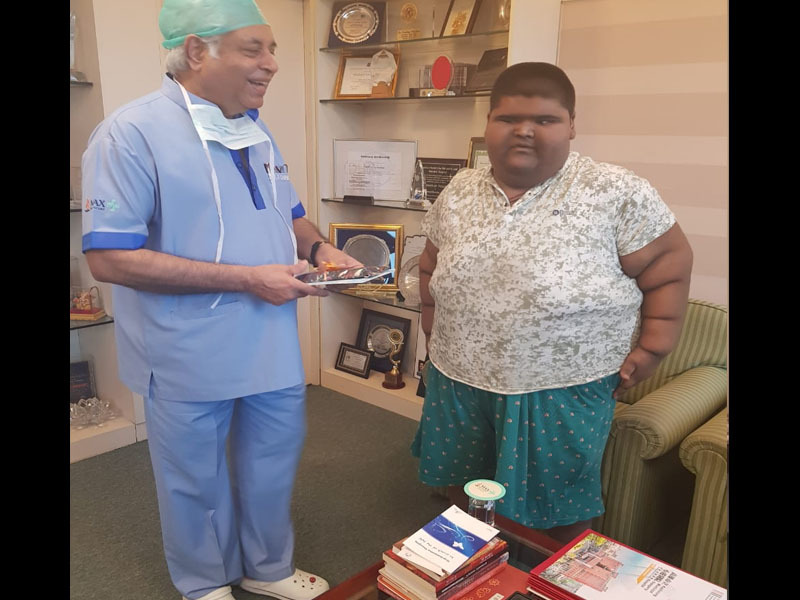
- Mihir Jain, 14, from Delhi, is the world’s heaviest teen to have undergone gastric bypass surgery.
- “Pasta is my favourite food. Pizza is second favourite,” Mihir Jain said.
NEW DELHI: The normal body mass index (BMI) – a person’s weight-to-height ratio – is 22.5 kg/m2. At 32.5, a person is considered obese and surgery may be suggested. A BMI above 40, 50 and 60 is categorised as morbid obesity, super obesity and super-super obesity, respectively. So what would you call a teenager, all of 14 years, with a BMI of 92?
Mihir Jain, a resident of Uttar Nagar in west Delhi, was that heavy when his parents brought him to Max hospital Saket a few months ago for weight reduction surgery. He could barely stand. When weighed, the teen turned out to be a staggering 237kg. Dr Pradeep Chowbey, a veteran bariatric surgeon who operated on him, said Mihir is the world’s heaviest teen to have undergone gastric bypass surgery.
“When I saw him first, I wasn’t confident on operating him successfully. He was too heavy for that,” said Dr Chowbey.
Mihir had a normal weight of 2.5kg when he was born in November 2013. But he gradually started gaining weight. By the time Mihir was five, he weighed 60-70kg, his mother Puja Jain said.
“Most members in our family are overweight so we didn’t take it seriously then. But then a time came when he couldn’t even walk properly due to heavy weight. He stopped going to school after Class II and I had to teach him at home,” Puja said.
The family had first sought medical help in 2010. But doctors at that said the boy was too young to undergo surgery.
‘Pasta my favourite food, pizza second’
“I stayed mostly in the house lying down or sitting,” Mihir said, happily declaring his love for junk food in the past. “Pasta is my favourite food. Pizza is second favourite,” he said.
Dr Chowbey put the boy on very low calorie diet (VLCD) initially because he wasn’t confident of successful surgery. A normal diet contains 2,500 to 3,000 calories. But VLCD give only about 800 calories.

The doctor said he thought the teen will not be able follow such restrictive diet and the family will not come back. “To my surprise, Mihir came to us again after four weeks. He had lost a good 10kg. I was happy to see their dedication and suggested them to continue the same diet for another two months which helped reduce the weight further to 196kg. But then we realised that for further reduction, surgery will be required and posted his case for operation in April,” Dr Chowbey, the chief of bariatric surgery at Max, said.
The biggest challenge in operating on an extremely obese person is in administering anaesthesia. This happens because of presence of fat in the tongue, throat and neck which restricts the space to put a tube into the lungs.
Dr Chowbey said they had to use special equipment – a flexible laryngoscope – to negotiate the difficult condition in Mihir’s case. “Also, there no guideline on the anaesthesia dosage for person weighing 200kg. Our doctors relied on their experience to decide on the right amount of anaesthesia,” he said.
Surgical manoeuvring inside the patient’s body was another difficulty. There were 10-12 inches of fat beneath the patient’s muscles which made operating difficult. Normal instruments aren’t that long or easy to manoeuvre so the doctors said they used longer instruments to reach the target area.
n a procedure lasting nearly two-and-a-half hours, doctors created a gastric bypass in which the digestive system is re-routed past most of the stomach which makes a person feel full on less food. “The surgery was uneventful and we were able to discharge Mihir within a week. He comes to the hospital for follow-up though. Also, he has been asked to continue the restrictive diet,” Dr Chowbey said.
Mihir’s mother said they’ve learnt a lesson from their crisis about the need to be physically active and avoid junk food. “Now I tell my daughter, Nandini, to eat wisely,” she said.




